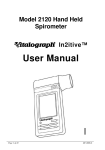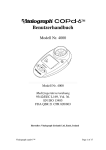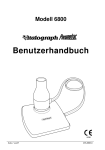Download User Manual - Vitalograph
Transcript
Vitalograph 4000 Respiratory Monitor copd-6TMusb User Manual Medical Devices Directive 93/42/EEC L169, Vol. 36. EN ISO 13485 FDA QSR 21 CFR 820/803 Manufacturer: Vitalograph (Ireland) Ltd, Ennis, Ireland Page 1 of 22 DT_0006-6 Vitalograph Ltd. Maids Moreton Buckingham MK18 1SW England Tel: +44 (0) 1280 827110 Fax: +44 (0) 1280 823302 e- mail: [email protected] Vitalograph Inc. 13310 West 99th Street Lenexa Kansa 66215 USA Tel: (913) 888 4221 Fax: (913) 888 4259 e-mail: [email protected] Vitalograph GmbH Jacobsenweg 12 22525 Hamburg Germany Tel: (040) 547391-0 Fax: (040) 547391-40 e-mail: [email protected] Vitalograph (Ireland) Ltd. Gort Road Business Park Ennis Co Clare Ireland Tel: (065) 6864100 Fax: (065) 6829289 e-mail: [email protected] www.vitalograph.com © Copyright Vitalograph 2008, 2010 Current Edition (Issue 2) Cat. No. 07409 Vitalograph is a registered trademark Page 2 of 22 DT_0006-6 Table of Contents WARNINGS AND ADVISORY NOTICES 4 MAIN COMPONENTS OF THE VITALOGRAPH COPD-6 USB 5 WHAT IS THE VITALOGRAPH COPD-6 USB USED FOR? 5 HOW TO USE THE VITALOGRAPH COPD-6 USB 6 ENTERING SUBJECT DATA PERFORMING THE TEST 6 7 SENDING TEST RESULTS TO VITALOGRAPH REPORTS 9 SETTING THE OBSTRUCTIVE INDEX AND COPD CLASSIFICATION ZONES 10 REVIEWING THE LAST SESSION TEST RESULTS 11 CARE AND CLEANING OF THE VITALOGRAPH COPD-6 USB 11 DAILY PROCEDURES MONTHLY PROCEDURES ANNUAL PROCEDURES TABLE OF MATERIALS USED & CLEANING/DISINFECTION METHODS REMOVING THE FLOWHEAD FOR CLEANING AND DISINFECTING 11 12 12 12 13 CONSUMABLES, ACCESSORIES AND SPARE PARTS 14 EXPLANATION OF SYMBOLS 15 TECHNICAL SPECIFICATIONS 16 CE NOTICE 16 FDA NOTICE 21 DECLARATION OF CONFORMITY 21 GUARANTEE 21 Page 3 of 22 DT_0006-6 Vitalograph copd-6 USB User Manual P/N: 07409 Issue 2 WARNINGS AND ADVISORY NOTICES Note: Please read all the information in this manual before using the Vitalograph copd-6 USB device. A full set of instructions, including cleaning instructions, is available at www.vitalograph.co.uk. x This Vitalograph device is intended to measure lung function for use in clinic with disposable mouthpieces or filters or for patient use at home under medical supervision. x Take care not to block the mouthpiece with the tongue or teeth. A ‘spitting’ action or coughing will give false readings. x If used at home symptoms must take precedence over device measurements*. x If the device is used for longer than its specified life, the accuracy of the device may deteriorate. x Before use, ensure that the batteries do not exceed their shelf life, as indicated on the batteries. x Store in a clean dry place. * If you suspect that a defect has occurred you should check the Vitalograph copd-6 USB device for operation and accuracy. Page 4 of 22 DT_0006-6 Vitalograph copd-6 USB User Manual P/N: 07409 Issue 2 MAIN COMPONENTS OF THE VITALOGRAPH COPD-6 USB A B C D E Flowhead On / off button Display User buttons USB connector A E B C D WHAT IS THE VITALOGRAPH COPD-6 USB USED FOR? The Vitalograph copd-6 USB is a device intended for measuring lung function. It can be used by a healthcare professional or assistant as a rapid pre-spirometry test to screen-out at-risk individuals that do not have COPD and indicate those that may be at risk of COPD at the presymptomatic stage of the disease. This “screening” or “case selection” for full spirometry examinations may result in earlier medical intervention and facilitate better clinical outcomes. Page 5 of 22 DT_0006-6 Vitalograph copd-6 USB User Manual P/N: 07409 Issue 2 The Vitalograph copd-6 USB displays some key parameters for clinical interpretation: x FEV1 and FEV1 % Predicted x FEV6 and FEV6 % Predicted x FEV1/FEV6 and FEV1/FEV6 % Predicted x FEV1/FVC ratio If an abnormal result is indicated, arrows on the display show: x Obstructive Index x COPD Classification (stages I - IV) HOW TO USE THE VITALOGRAPH COPD-6 USB Entering Subject Data The subject’s physical data can be entered into the Vitalograph copd-6 USB in order to calculate predicted data. To enter the subject data, follow these steps: 1. Turn the device on, D. 2. The age can now be set ( ). This is done by pressing the B or C button and releasing when the age is reached. The values will increase/decrease in values of 1. If the button is kept depressed, the values will scroll faster. Press the E button to set the age. 3. The height can now be set ( ). This is done by pressing the B or C button and releasing when the height is reached. The values will increase/decrease in values of 1. If the button is kept depressed, the values will scroll faster. Press the E button to set the height. Note: if height values are set below 100, the device assumes height is in inches and that Weight will be in Ibs rather than Kg. 4. The gender can now be set ( ). This is done by pressing the B or C button and releasing when the correct gender is showing. (Male Page 6 of 22 DT_0006-6 Vitalograph copd-6 USB User Manual P/N: 07409 Issue 2 ( ); Female ( )) Press the E button to set the gender. After gender is selected, the Vitalograph copd-6 USB will go to Test Mode, where the Blow Icon is showing. On some variants, an additional data field comes first (see below) 5. (This step may be omitted, depending on the variant) The Population Group (On some variants this is Weight instead) can now be set ( ). This is done by pressing the B or C button and releasing when the desired setting is reached. Press the E button to set. Set No. 1 2 3 Example Population Group NHANES III Caucasian NHANES III African-American NHANES III Hispanic-American C AA HA Performing the Test 1) The subject should sit down when blowing into the device (unless advised otherwise). Insert a new disposable SafeTway mouthpiece into the device. 2) Turn the device on, D (if not already ON). When the device is ready for a test the blow icon shows ( ). 3) Instruct the subject and demonstrate (using a mouthpiece) as follows: a) “Hold your head up, breathe in as deeply as possible, hold the device in front of your mouth”. b) “Hold your breath, place the mouthpiece into your mouth, like this, bite the mouthpiece lightly, and seal your lips firmly around it, like this”. I will demonstrate. c) “Blow out as HARD, and FAST as you can, like this, until I tell you to stop” (the unit will beep at end of test - after 6 seconds). Page 7 of 22 DT_0006-6 Vitalograph copd-6 USB User Manual P/N: 07409 Issue 2 d) “Be careful not to block the mouthpiece with your tongue or teeth. A ‘spitting’ action will give false readings”. e) “Now you do it – deep breath in – bite and seal – blast the air out…keep going – keep blowing” f) “Well done!” “Now, we need to do that three times. Rest for a while until you are ready to blow again”. 4) To view the result (the best values in the session), press the E button. a) The COPD Classification will show on the right hand arrow. i) Green is NORMAL, negative for COPD. No need to refer this subject for spirometry. ii) Any one of the blue zones, I, II, II or IV are not normal. This subject should be referred for spirometry. b) The Obstructive Index (OI) shows on the left hand arrow. i) 0 - Green is normal. ii) 1, 2 or 3 – Yellow, amber or red are not normal. Refer for spirometry, but this is unlikely to be COPD. iii) Note: If the right hand (COPD) arrow is not green, nor will the left hand (OI) arrow be green. 5) This is the end of the test, but if desired some test parameters may be viewed. 6) Following each blow and at the end of the test session, the FEV1 value will be displayed and below that, FEV1 % Predicted results for that blow, or for the best in session if the E button has been pressed. Pressing E again will toggle between best and last blow. 7) Pressing the B button will show the FEV6 and FEV6 % Predicted results. 8) Pressing the B button again will show the FEV1/FEV6 and FEV1/FEV6 % Predicted results 9) Press the B button for a final time will show the estimated Lung Age ( Page 8 of 22 ) DT_0006-6 Vitalograph copd-6 USB User Manual P/N: 07409 Issue 2 Notes on testing: ! 1. During testing, if an exclamation mark appears, this means that the last blow was not a good quality blow and the user should blow again. Reasons for poor quality are; a. Slow Start of test: Vext (extrapolated volume) is > 5% or 150mL of FEV6 b. Cough detected. 2. In the event that a test is < 3 seconds duration and has an abrupt end (change in volume is > 25ml in the last second of the test), the value FEV will be displayed instead of FEV6. 3. If the test subject experiences side effects such as dizziness or fatigue during the test procedure, stop testing until recovered. SENDING TEST RESULTS TO VITALOGRAPH REPORTS The test session may be transmitted to the Vitalograph Reports Utility on your PC where it can be stored as a PDF file and viewed or printed. Before you can transmit you must first have the Vitalograph Reports Utility installed and running on your PC. If the ‘Snake V’ icon is showing in your PC System Tray then the utility is running, if not refer to Vitalograph Reports Utility instructions. 1. Connect the Vitalograph copd-6 USB device to the PC using the USB cable supplied. 2. On Vitalograph Reports ensure ‘Vitalograph copd-6’ is selected as the device. 3. There are two ways to print the test results from the copd-6; a. When the device is ready for a test ( ), press the B button for 3 seconds on the device will show the Report icon ( ). b. After completing the test session, press the B or C button until the print ( ) screen is displayed. Press E. Page 9 of 22 DT_0006-6 Vitalograph copd-6 USB User Manual P/N: 07409 Issue 2 4. On the Vitalograph Reports enter the Subject Demographic details and Comments. Select ‘Continue’ on Vitalograph Reports when you are finished entering the information. 5. Select a location for the test report on your PC as requested by Vitalograph Reports. A PDF of the test results will appear and will also be stored to the PC. Setting the Obstructive Index and COPD Classification Zones The Vitalograph copd-6 USB Obstructive Index and COPD Classification zones are set by the manufacturer to the GOLD (Global Initiative for Chronic Obstructive Lung Disease) standard and it is unlikely that a user will wish to change this – however if this is required please follow the following instructions; The colour systems for each zone type are pre-set as follows; FEV1%Pred. ≥ 80% Obstructive Index 0 Top boundary < 80% 1 < 50% 2 < 30% 3 Middle boundary Bottom boundary COPD Classification Not COPD FEV1/FEV6 Ratio and FEV1%Pred. FEV1/FEV6 > 0.7 Stage I FEV1/FEV6 < 0.70 and FEV1 ≥ 80% Pred. FEV1/FEV6 < 0.70 and FEV1 < 80% Pred. FEV1/FEV6 < 0.70 and FEV1 < 50% Pred. FEV1/FEV6 < 0.70 and FEV1 < 30% Pred. Stage II Stage III Stage IV To set the boundary percentage values for both the Obstructive Index and COPD Classification zones together, follow these steps; 1. Turn the device on, D. 2. When the icon appears, press and hold the E and B buttons for approximately 3 seconds. 3. The top boundary can now be set. This is done by pressing the B or C button and releasing when the value is reached. The values will increase/decrease in values of 1%. If the button is kept depressed, the values will scroll faster. 4. Press E to set the top boundary value. Page 10 of 22 DT_0006-6 Vitalograph copd-6 USB User Manual P/N: 07409 Issue 2 5. The middle boundary can now be set. This is done by pressing the B or C button and releasing when the value is reached. The values will increase/decrease in values of 1%. If the button is kept depressed, the values will scroll faster. 6. Press E to set the middle boundary value. 7. The bottom boundary can now be set. This is done by pressing the B or C button and releasing when the value is reached. The values will increase/decrease in values of 1%. If the button is kept depressed, the values will scroll faster. 8. Press E to set the bottom boundary value. 9. Press E. The device will return to the age entry screen. Reviewing the Last Session Test Results The Vitalograph copd-6 USB will always store the last test session, even after the device has powered itself down or has been switched OFF. In order to view the last test session, follow these steps; 1. Turn the device on, D. 2. When the device is ready for age entry ( ), press the E button for approximately 3 seconds. The last test session (best results) data will now show again. 3. When you have finished reviewing the data, press the OFF button for 3s. OR 4. Press E. The device will return to the age entry screen ready for entering the next test subject’s data. CARE AND CLEANING OF THE VITALOGRAPH COPD-6 USB Daily Procedures A new mouthpiece (either SafeTway or BVF) should be used for each subject. A delay of at least 5 minutes should be allowed between subjects to allow settling of previously aerosolized particles in the measuring device. Page 11 of 22 DT_0006-6 Vitalograph copd-6 USB User Manual P/N: 07409 Issue 2 Monthly Procedures It is recommended that the device be regularly cleaned according to the guidelines of the user’s facility. The disinfection materials and procedures applied in the users’ facility may be more appropriate than the methods outlined below. In the event of visible contamination of the flowhead element, it should be cleaned or disinfected as described in the accompanying table. The device should be replaced in the event of damage, or if visibly contaminated. The frequency of cleaning and disinfecting is dependent on the facility’s risk assessment, usage, and test environment, but it should be at least monthly or every 100 subjects (300 blows). Annual Procedures It is recommended that the device be replaced annually or test and calibration serviced at least annually. There is no planned preventive maintenance for this medical device. Table of Materials Used & Cleaning/Disinfection Methods This listing of materials used is given to provide clinical users with information to allow the assessment of other cleaning and disinfecting procedures available in the facility on this device. Part Material SafeTway mouthpiece or BVF Case Exterior Fascia Cardboard / ABS Page 12 of 22 PC/ABS Clean/ Disinfect Dispose – single use Clean PMMA/PET Clean Autoclave Possible? No Recommended Disinfectants Dispose – single use No Wiping with a 70% isopropyl alcohol impregnated cloth provides a suitable form of cleaning and low-level disinfection. This may be preceded by cleaning with an anti-static foam cleaner if necessary. No DT_0006-6 Vitalograph copd-6 USB User Manual P/N: 07409 Issue 2 Removable flowhead PC/ABS Clean No Disinfect by immersion in sodium dichloroisocyanurate solution at 1000 ppm concentration of free chlorine for 15 minutes (see following section for recommended cleaning/disinfection method for the flowhead) All external parts of the Vitalograph copd-6 require cleaning, i.e. the removal of visible particulate contamination. The parts of the device that make up the flowhead, which comes into contact with the breath of the subjects being tested, also require disinfecting. This device is not designated as a ‘sterile’ device. Removing the Flowhead for Cleaning and Disinfecting 1. Remove the flowhead from the body with a sharp pulling motion. 2. Clean the flowhead by washing in a mild detergent to remove particulate contamination, taking care not to touch the moving vanes. Swill vigorously in water with mild detergent. Do not attempt to “rub” or “scrub” in the area of the vanes. Rinse with clean water. 3. Disinfect by immersion in sodium dichloroisocyanurate solution at 1000 ppm concentration of free chlorine for 15 minutes. Prepare disinfectant solution as directed in the manufacturer’s guidelines. Rinse with warm water for faster drying. 4. Leave it to dry completely before reassembling. Drying the flowhead may require placing it in a warm place overnight. A drying cabinet is ideal. Wiping with a 70% Isopropyl Alcohol impregnated cloth provides a suitable form of cleaning and low-level disinfection for the case Page 13 of 22 DT_0006-6 Vitalograph copd-6 USB User Manual P/N: 07409 Issue 2 exterior, display, screen surround and keys. Repeat this at least weekly to prevent a build-up of grime from normal handling and use. Always follow the safety guidelines given by the manufacturer of cleaning and disinfectant chemicals or equipment. Reassemble the flowhead by pushing back on until it ‘clicks’ into position. Ensure that the flowhead is pushed fully home. When the flowhead is reassembled, it is good practice with any respiratory measuring device for an accuracy check be performed using a Precision Syringe, with the volume delivered in less than one second. An accuracy of +/- 3% should be achieved. Definitions of cleaning and disinfection are as defined in “Sterilization, Disinfection and Cleaning of Medical Equipment: Guidance on Decontamination from the Microbiology Committee to Department of Health Medical Devices Directorate, 1996” Recommendations for chemical disinfectants are derived from the PHLS publication “Chemical Disinfection in Hospitals” 1993 CONSUMABLES, ACCESSORIES AND SPARE PARTS Cat. No 20242 20303 20980 20991 28350 40167 Page 14 of 22 Description SafeTway Mouthpieces (200) Disposable Noseclips (200) Mini SafeTway£ mouthpieces (50) Long SafeTway£ mouthpieces (130) BVF£ Bacterial/Viral Filters (50) Pouch Spare (x10) DT_0006-6 Vitalograph copd-6 USB User Manual P/N: 07409 Issue 2 EXPLANATION OF SYMBOLS Device symbols; k Type BF equipment j Class II The device must be taken to separate collection at the product end-of-life. Do not dispose of these products as unsorted municipal waste. Attention (reference relevant section in manual) USB connector h User Interface Symbols; Battery status Battery status Full Battery status Half Battery status Quarter Battery status Empty (flashing) Blow Now Symbol ! Bad Test Symbol (Slow start or Cough) Unit of weight measurement Lung Age Symbol Age Symbol Height Symbol Gender Symbol Population Group Symbol Transmit Report Symbol Page 15 of 22 DT_0006-6 Vitalograph copd-6 USB User Manual P/N: 07409 Issue 2 TECHNICAL SPECIFICATIONS Material: Accuracy: Flow Impedance: Measurement Range: Performance And Safety Standards: Electromagnetic emissions: Electromagnetic immunity: Sensor Power Supply Operating Temperature ! Bad Test Criteria FEV substituted for FEV6 Auto power down time Communications PC/ABS Better than ± 3% (FEV1 & FEV6), ± 3% (PEF) Better than 0.15kPa/L/s at 14L/s FEV1: 0 – 9.99 L BTPS FEV6: 0 – 9.99 L BTPS ATS/ERS Guidelines 2005 CISPR 11 Group 1 (battery operated) IEC 61000-4-2, IEC 61000-4-3 (battery operated) Stator/rotor 2 x AAA batteries 17 – 37°C Slow start of test (Vext>5%) or a cough detected in the first second When FET < 3s and abrupt end of test Set to 2 minutes as standard USB CE NOTICE l Marking by the symbol indicates compliance of the Vitalograph 4000 Respiratory Monitor copd-6 device to the Medical Devices Directive of the European Community. Such marking is indicative that the Vitalograph 4000 Respiratory Monitor copd-6 device meets or exceeds the following technical standards: Page 16 of 22 DT_0006-6 Vitalograph copd-6 USB User Manual P/N: 07409 Issue 2 Guidance and manufacturer’s declaration – electromagnetic emissions The 4000 Respiratory Monitor copd-6 is intended for use in the electromagnetic environment specified below. The customer or the user of 4000 Respiratory Monitor copd-6 should assure that it is used in such an environment. Emissions test Compliance Electromagnetic environment – guidance RF emissions Group 1 The 4000 Respiratory Monitor copd-6 uses RF CISPR 11 energy only for its internal function. Therefore, its RF emissions are very low and are not likely to cause any interference in nearby electronic equipment. RF emissions Class B The 4000 Respiratory Monitor copd-6 is CISPR 11 suitable for use in all establishments, including domestic establishments and those directly Harmonic emissions Class A connected to the public low-voltage power IEC 61000-3-2 supply network that supplies buildings used for Voltage fluctuations/ Class A domestic purposes. flicker emissions IEC 61000-3-3 Page 17 of 22 DT_0006-6 Vitalograph copd-6 USB User Manual P/N: 07409 Issue 2 Guidance and manufacturer’s declaration – electromagnetic immunity The 4000 Respiratory Monitor copd-6 is intended for use in the electromagnetic environment specified below. The customer or the user of the 4000 Respiratory Monitor copd-6 should assure that it is used in such an environment. Immunity test IEC 60601 Compliance Electromagnetic environmentTest level level guidance Floors should be Electrostatic ±6 kV contact ±6 kV wood, concrete or discharge (ESD) contact ceramic tile. If floors IEC 61000-4-2 ±8 kV air are covered with ±8 kV air synthetic material, the relative humidity should be at least 30% Electrical fast transient/burst IEC 61000-4-4 Surge IEC 61000-4-5 Voltage dips, short interruptions and voltage variations on power supply input lines IEC 61000-4-11 Power frequency (50/60 Hz) magnetic field IEC 61000-4-8 Page 18 of 22 ±2 kV for power supply lines ±1 kV for input/ output lines ±1kV differential mode ±2kV common mode Battery operated device <5 % 100V (>95% dip in 100V) for 0,5 cycle 40 % 100V (60% dip in 100V) for 5 cycles 70 % 100V (30% dip in 100V) for25 cycles <5% 100V (>95% dip in 100V) for 5 sec 3 A/m Battery operated device Battery operated device Performance A Power frequency magnetic fields should be at levels characteristic of a typical location in a typical commercial or hospital environment. DT_0006-6 Vitalograph copd-6 USB User Manual P/N: 07409 Issue 2 Guidance and manufacturer’s declaration – electromagnetic immunity The 4000 Respiratory Monitor copd-6 is intended for use in the electromagnetic environment specified below. The customer or the user of the 4000 Respiratory Monitor copd-6 should assure that it is used in such an environment. Immunity IEC 60601 Compliance Electromagnetic environment test Test level level guidance Portable and mobile RF communications equipment should be used no closer to any part of the 4000 Respiratory Monitor copd-6 including cables, than the recommended separation distance calculated form the equation applicable to the frequency of the transmitter. Recommended separation distance Conducted RF IEC 61000-4-6 10 Vrms 150kHz to 80 MHz in ISM bands Battery operated device d 0.35 P Radiated RF IEC 61000-4-3 3 V/m 80 MHz to 2,5 GHz 3V/m from 80MHz to 2.5 GHz d 0.35 P d 0.7 P 80MHz to 800MHz 800MHz to 2.5GHz Where P is the maximum output power rating of the transmitter in watts (W) according to the transmitter manufacturer and d is the recommended separation distance in metres (m). Field strengths from fixed RF transmitters, as determined by an electromagnetic site survey, should be less than the compliance level in each frequency range. Interference may occur in the vicinity of equipment marked with the following symbol: Page 19 of 22 DT_0006-6 Vitalograph copd-6 USB User Manual P/N: 07409 Issue 2 Recommended separation distances between portable and mobile RF communication equipment and the 4000 Respiratory Monitor copd-6 The 4000 Respiratory Monitor copd-6 is intended for use in an electromagnetic environment in which radiated RF disturbances are controlled. The customer or the user of the 4000 Respiratory Monitor copd-6 can help prevent electromagnetic interference by maintaining a minimum distance between portable and mobile RF communications equipment (transmitters) and the 4000 Respiratory Monitor copd6 as recommended below, according to the maximum output power of the communications equipment. Rated maximum Separation distance according to frequency of output power of transmitter (m) transmitter 150 kHz to 80 80 MHz to 800 800 MHz to 2.5GHz MHz MHz d = 2.3P W d = 1.2P d = 1.2P 0.01 0.1m 0.1m 0.2m 0.1 0.4m 0.4m 0.7m 1 1.2m 1.2m 2.3m 10 3.7m 3.7m 7.4m 100 11.7m 11.7m 23.3m For transmitters rated at a maximum output power not listed above, the recommended separation distance d in metres (m) can be estimated using the equation applicable to the frequency of the transmitter, where P is the maximum output power rating of the transmitter in watts (w) according to the transmitter manufacturer. NOTE 1 At 80 MHz and 800 MHz, the separation distance for the higher frequency range applies. NOTE 2 These guidelines may not apply in all situations. Electromagnetic propagation is affected by absorption and reflection from structures, objects and people. Medical Devices may be affected by cellular telephones and other personal or household devices not intended for medical facilities. It is recommended that all equipment used near the Vitalograph product comply with the medical electromagnetic compatibility standard and to check before use that no interference is evident or possible. If interference is suspected or possible, switching off the offending device is the normal solution, as is required in aircraft and medical facilities. Medical electrical equipment needs special precautions regarding EMC and needs to be installed and put into service according to the EMC information provided, Page 20 of 22 DT_0006-6 Vitalograph copd-6 USB User Manual P/N: 07409 Issue 2 Portable and mobile RF communications equipment can affect medical electrical equipment. FDA NOTICE Caution: Federal Law restricts this device to sale by, or on the order of a physician. DECLARATION OF CONFORMITY Product: Vitalograph 4000 Respiratory Monitor copd-6 Vitalograph hereby ensures and declares that the above product associated with this user manual, is designed and manufactured in accordance with the following QMS regulations and standards: European Medical Devices Directive {MDD} 93/42/EEC. This device, classified as 2a as per Annex IX of MDD 93/42/EEC, meets the following provisions of Annex II of the Medical Devices Directive as per Article 11, section 3a, excluding point 4 of Annex II. This device complies with the EMC Directive 89/336/EC, conformance demonstrated by following standard EN606011-2:2001. Equipment classification: Residential. Canadian Medical Device Regulation {CMDR} FDA Quality System Regulation {QSR} 21 CFR 820. EN ISO 13485: 2003. Medical devices. Quality management systems. Requirements for regulatory purposes. Certifying Body {for 93/42/EEC and CMDR}: British Standards Institute {BSI} Certificate Nos. CE 00772, MD 82182, FM 83550 l GUARANTEE Subject to the conditions listed below, Vitalograph Ltd. and its associated companies, (hereinafter called the Company) guarantee to repair or at its opinion replace any component thereof, which, in the opinion of the Company is faulty or below standard as a result of inferior workmanship or materials. The conditions of this Guarantee are: 1. This Guarantee shall only apply to hardware defects which are notified to the Company or to its accredited distributor within 1 year Page 21 of 22 DT_0006-6 Vitalograph copd-6 USB User Manual P/N: 07409 Issue 2 2. 3. 4. 5. 6. 7. 8. of the date of purchase of the equipment, unless otherwise agreed in writing by the Company Software (meaning computer software, or user installable modules) is guaranteed for 90 days from the date of purchase. The Company warrants that the software when correctly used in conjunction with the hardware will perform in the manner described in the Company's literature and user manuals. The Company undertakes to rectify at no expense to the customer any software failure notified within the period stated above, provided that the failure can be recreated and the software has been installed and used in accordance with the user manual. Notwithstanding this clause, the software is not warranted to be free of errors. This Guarantee does not cover any faults caused by accident, misuse, neglect, tampering with the equipment, use of consumable items or parts not approved by the Company, or any attempt at adjustment or repair other than by personnel accredited by the Company, nor does it cover reinstatement of any configuration changes caused by the installation of any software. If a defect occurs, please contact the supplier from whom it was purchased for advice. The Company does not authorise any person to create for it any other obligation or liability in connection with Vitalograph equipment This Guarantee is not transferable and no person, firm or company has any authority to vary the terms or conditions of this Guarantee. To the maximum extent permitted by law, the Company does not accept liability for any consequential damages arising out of the use of, or inability to use any Vitalograph equipment. This Guarantee is offered as an additional benefit to the Consumer’s statutory rights and does not affect these rights in any way. Page 22 of 22 DT_0006-6




























